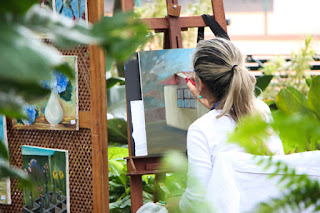What is that all about?
My advice to my students is to follow only three rules.
If they do, I can guarantee that their creativity will increase tremendously.
1-Stop Thinking
I know this may be shocking at first, perhaps impossible, to do, but what it means is that we need to stop comparing and judging, we need to forget what we have learned from childhood, erase everything that someone said is right or wrong aesthetically. It means that we need to leave all the prejudices we carry around. Not easy indeed. Stop thinking allows your intuition to take charge.
Usually, one of the biggest obstacles to our creativity is the fear of making mistakes. And although painting errors are not life or death situations, people often tend to freeze. "Stop thinking" encourage students to start making mistakes, and mistakes have a way of teaching us things that will stay with us for the rest of our life. Making mistakes will get us to places we never thought we could access. When accidents happen a new knowledge is discovered.
2-Work without a vision
Without a model, with nothing to be copied. I give a starting point, the same for everyone, for example, you need to create only with two colors. I do not show any examples or pictures, therefore students need to work with the only resource they have left: themselves.
We are accustomed to having a goal all the time, probably because a goal gives us a sense of security. There is a pattern to follow, something to grab onto. However, when there are no goals, there is nothing to hold onto, the only alternative is to learn to trust yourself. This means that you follow what it is happening at the moment, selecting the colors you need, following the hints the composition is showing you and the sensations you're having. When this happens is when you start waking up your creativity using your intuition.
My experience has taught me that from six people doing the same exercise, there are six very different results in which you can clearly see the individuality of each person.
3-Do not fall in love

Do not get attached to what you are doing. Many times there is a part of the painting that you really like, but the rest is not solved. When this happens, the part you like is preventing you to solve the rest, somehow that particular area will not let you be free. Learn to let go.
In real life as in painting, objectivity is necessary, because if you are not disengaging, that emotional interest will hold you back. Flexibility and neutrality are essential.
The way you behave painting is a reflection almost identical to the way you behave in real life. The experience of developing your own creativity by:
- Be flexible
- Take risks
- Always question twice what you see
- Don't think about prototypes
- Be objective
- Enjoy the adventure
- Be more curious
If you are a teacher, or an artist, try to apply these three rules in your next assignment or artwork and you will see a big difference.
You can start here. Try these rules today following my Free Painting Tutorial.
By Isabel Kumerz



